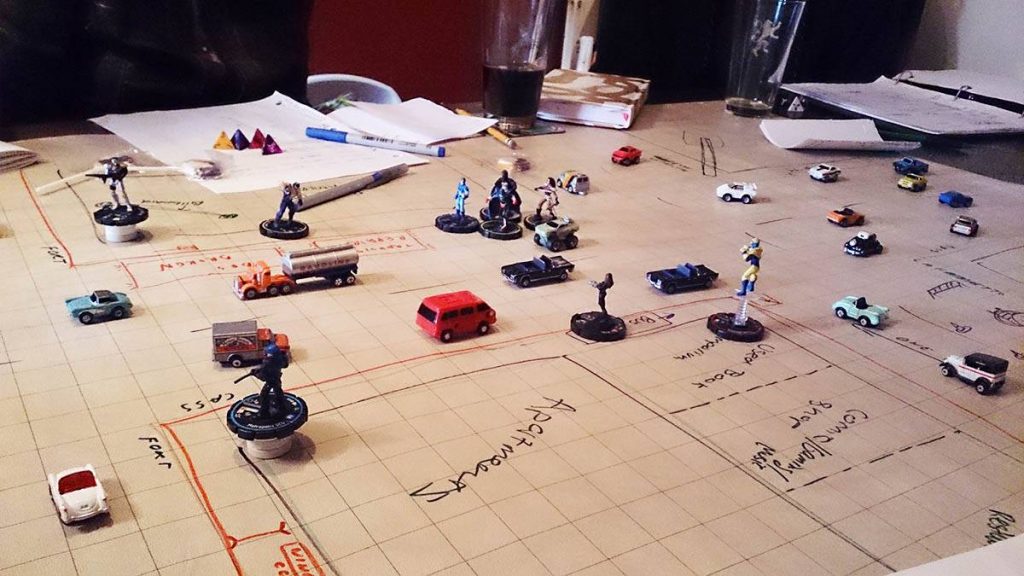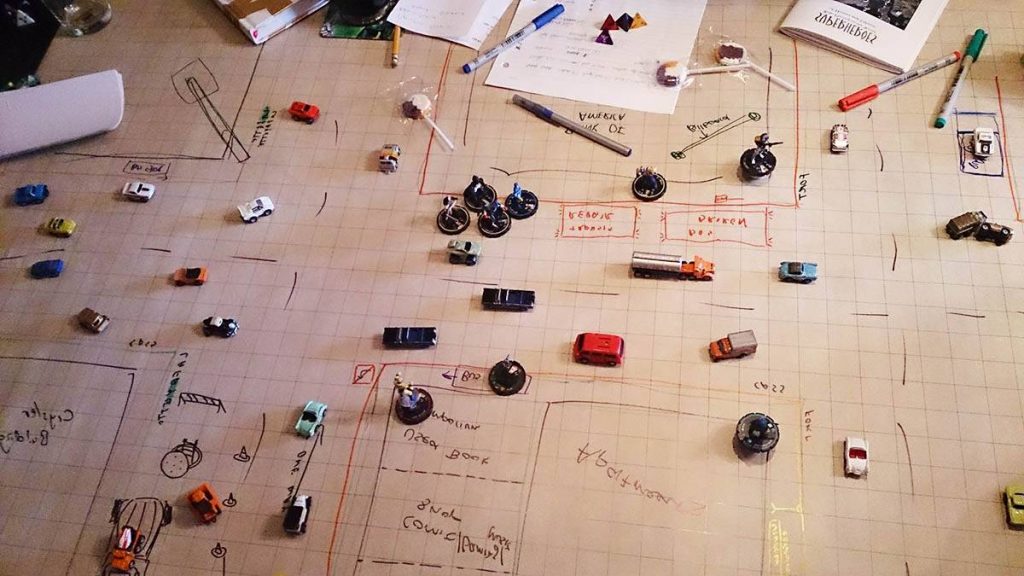Today’s guest article is by the awesome Craig Dedrick, who handed off the task of making maps to his players and wrote about the experience. Hum the Indiana Jones theme song in your head as you read. – Cartographer John

In general, one of the things that I take great delight in as a game master is the process of preparing for a game. Finding the monsters/antagonists, coming up with NPC’s, and figuring out encounters and plot points is great fun. However, like many pleasant jobs, there are some tasks that are less enjoyable. For me, the unpleasant part of game preparation is making encounter maps.
Don’t get me wrong — I love a good map. However, coming up with a good map is a painful process, and more often than not I just “phone it in” and modify the same old house floor plan, wooded clearing, or 9-room dungeon. However, of late, I have come up with a different solution entirely. I ask my players to draw my maps!
Getting Your Players To Do The Work
I am lucky to have several players with some map-drawing or general artistic talent. When running a super hero game a little while ago, I had neglected to come up with a street map for an intersection where the heroes were planning to stop the nefarious plans of a group of villains. I also had to deliver some private information to one player, and I had to get my super villain combat information organized and ready to go. Rather than let the game grind to a halt while I got my notes together, met privately with a player, AND drew a battle map, I chose to delegate the map drawing to the remaining players. I simply gave them some guidelines: “I need an intersection with at least one tall building and plenty of traffic.” From there, I was able to accomplish my tasks without leaving the other players bored. On the contrary, they seemed to take great delight in creating a map for the big encounter.
By the time all was said and done, I had noted the following benefits from the technique:
- The players are able to include terrain elements that they find exciting for their characters, and give them opportunities to exhibit powers/abilities that would not have occurred to me.
- Players are surprisingly keen to build in hazards or obstacles that will make life difficult for them. I had not anticipated this benefit.
- If the map doesn’t quite do everything that I wanted it to do, I am able to make a slight adjustment. This takes a fraction of the time it would have taken me to make the map from scratch.
- Players remain engaged while I take care of side-business.
- 5 heads are better than one. Five players create a map with more detail and points of interest than I was likely to create by myself.
- Players do not feel like I have “stacked the deck” against them by creating an unreasonable terrain advantage for the bad guys. They have only themselves to blame!
- Artistic or map-inclined players are able to contribute at a level that they are normally unable to during the game.
- As players draw the map, they explain the features to the other players in great detail. A detailed visual picture is painted easily and naturally for everyone at the table.
As you can see in the photos, the players included plenty of detail, including types of businesses, some construction, a crane atop a building (!!!), an open manhole, broken-down vehicles blocking traffic, etc. For once, my tendency to procrastinate unpleasant tasks has yielded a great benefit, and I will definitely be using this technique again.

What do you think? Do you have other strategies for delegating tasks to players during the session? Would you be able to trust your group to make the battle map for a big encounter? A small one? Have you tried something similar?

















I hardly ever use maps. The closest I get is a rough sketch when it becomes clear there is some confusion, or if the PCs are initiating an attack and have had opportunity to scout and plan before hand. Otherwise they don’t exist at my game table .
Oh man, I am the opposite. I love map making, my dungeons tend to be complex twisted trap filled monster paradises. The idea of players making the battlefield is great, I may incorporate this. Good work!
That’s awesome! What an ingenious way to keep the players engaged while you passed info to the other player and got your notes together. I haven’t decided if we’ll be using minis for my revived Pathfinder game this fall, but if I do, I just may steal this idea.
I might do something like this with my Changeling chronicle. The PCs are supposed to be reasonably familiar with the area, and if they made the landmarks, they’re more likely to remember them. It also gives them a chance to create places that tie them to the wider world, like where they live, work, shop, and so on.
Also, note to self: Get toy cars. I’ve got a bunch of modern maps recently, and it’d help to have a quick way to fill out the parking lots. Plus, it’d be a convenient way to mark the group’s location on the city map.
The cars are not to scale, but they get the idea across… and I can move them around easily!
Those are great examples, Craig. It’s great that your players really get into the task and create some inspired designs. My LT group is nowhere near as creative, unfortunately. They usually get that deer-in-the-headlights look when I invite them to collaborate on drawing a map and basically freeze until I spoonfeed them instructions. “Make the building’s footprint 40×40′. No, 40′ is 8 squares. There’s an alley on the far side 20′ wide. No, that should be 4 squares across. Now scatter some dumpsters along the sides of the alley. No, I don’t care exactly which squares they’re in.” (By the way, these are players with an average of 20 years FRPG experience, not kids playing dice-and-paper for the first time!)
So here’s a piece of advice for GMs whose players fumble with maps and don’t enjoy doing it themselves: get over it! Practice breaking down the intimidating task of creating a map into manageable steps. For example, first decide what’s in the area, broadly speaking; then sketch out general shapes; and finally add details that make it feel fully fleshed out so it’s not just “Here’s another building….” By taking this kind of approach I’ve overcome my own tendency to spin my wheels when trying to draw a map and created some designs that wind up being awesome set-pieces my group can use for multiple gaming sessions.
Good advice, Blackjack. I am certainly blessed to have not only artistically inclined players, but I frequently have players who also GM on a regular basis which gives them some map-making experience to draw upon. #punintended
I love this approach, but unfortunately don’t see a way to implement it at the virtual table. For a physical session combining this approach with a box of legos for terrain building would allow for players to create quick and easily destructible terrain.